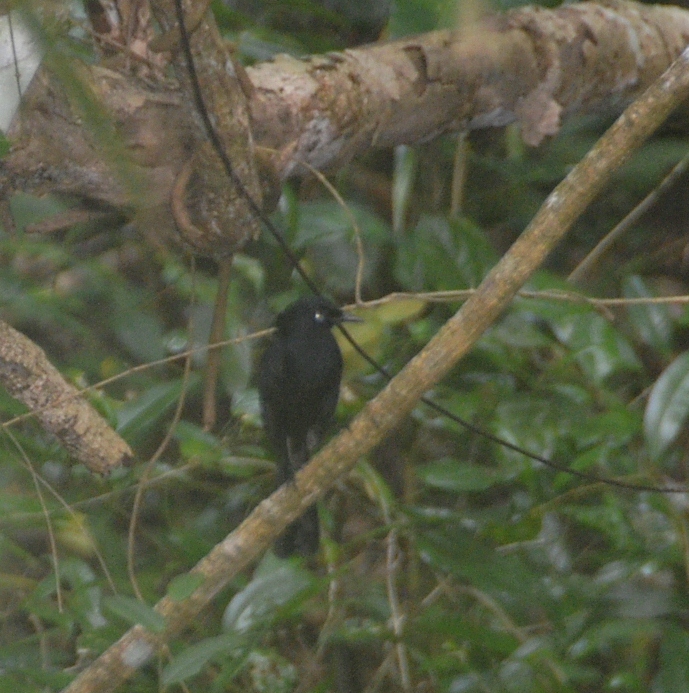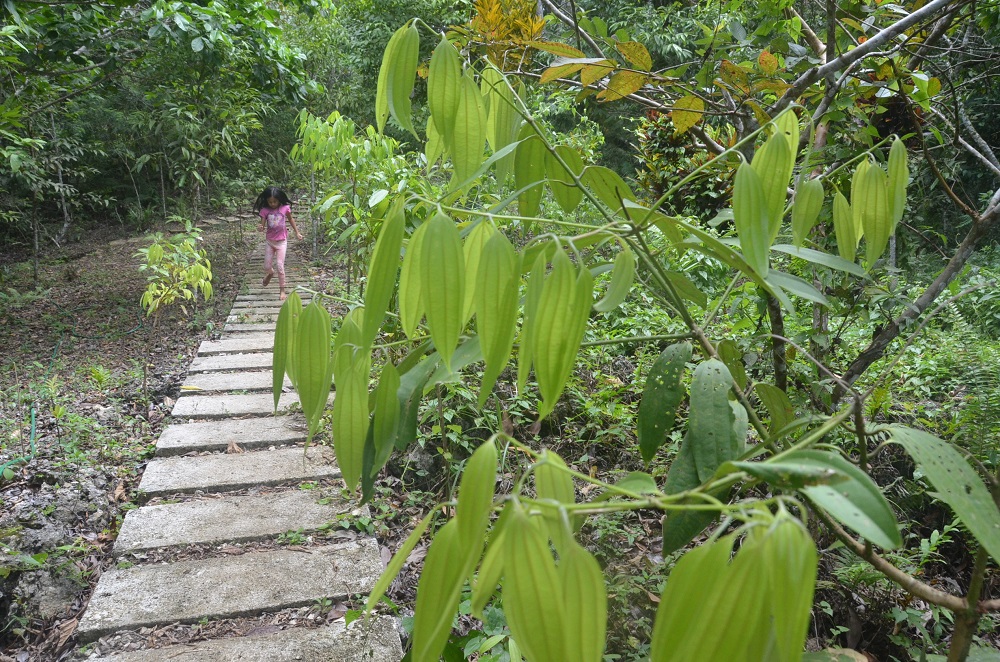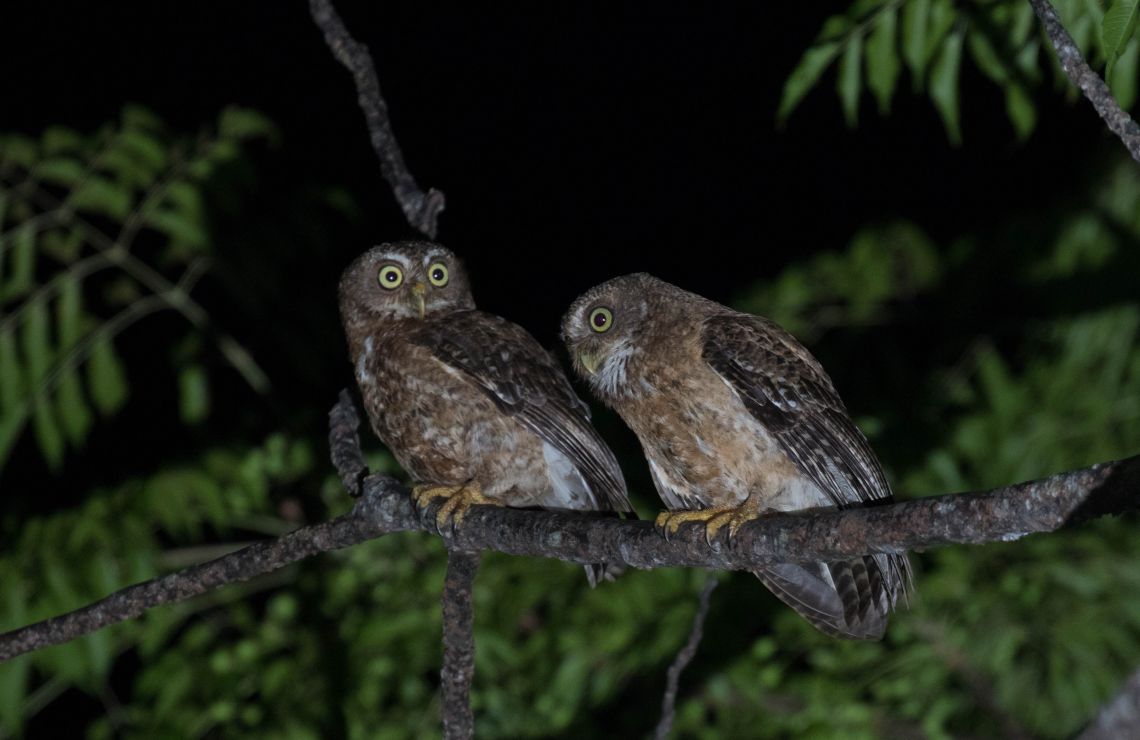Songbirds have started singing again in the last patch of forest in the Cebu municipality of Alcoy, rejuvenated and protected in the last 15 to 20 years by a determined community of upland farmers.
Early morning of November 9, 2019, Jaime Getaruelas, a community forest warden in Nug-as Karst Forest, some 100 km south of the provincial capital, guided four bird enthusiasts into a known habitat of the endangered songbird Cebu Black Shama (Copsychus cebuensis), commonly known as Siloy.

Black Shama or Siloy bird in Nug-as Forest Reserve, Alcoy, Cebu. Photo by Cooper Resabal.
In a slow lilting whistle, the guide approximated the Siloy bird call twice. On his third call deep in the limestone forest, the territorial bird replied with a call so clear and near. This excited the group of Bio Campers, which was told to look straight at a vine some five meters ahead where a medium-sized Cebu Black Shama was perched. After ten seconds, before anyone could take a photo, it flew away.
The Black Shama is in the International Union for the Conservation of Nature (IUCN) list of threatened species.
Nowhere else in the world can anyone find this species (Cebu Black Shama), but it lives in Cebu which has very minimal forest cover, according to Liza Paguntalan, wildlife biologist and executive director of the Philippine Biodiversity Conservation Foundation, Inc. (PBCFI), based on local media reports.
Aside from the Black Shama, there are 12 globally threatened birds found in Cebu, and three are found only on the island, namely, the Cebu Flowerpecker (Dicaeum quadricolor), Cebu Brown Dove (Phapitreron amethystinus frontalis), and Cebu Hawk Owl (Ninox rumseyi). The Cebu Flowerpecker has only been sighted and painted, but not photographed, a report from PBCFI, also known as PhilBio, says.

Cebu Flowerpecker Portrait
Among the plants, there are only 130 Cebu Cinnamon mother trees left, according to reports from the PhilBio field office.
Daily, the field office adds, these plants and birds face the danger of becoming extinct as harmful practices, such as slash and burn farming and logging, persist.

Cebu Cinnamon leaves on young tree. Photo by Cooper Resabal.
PhilBio’s field projects officer Andrew Ross Reintar said some fauna in Cebu have in fact become extinct, like the Philippine Cockatoo-Cebu, White-bellied Woodpecker, Visayan Spotted Deer, Visayan Warty Pig and Cebu Pygmy Buffalo.
Andrew Ross Tse Reinter, PhilBio Field Projects Officer, shares that there is only a 0.03% forest cover in Cebu Island, and the Nug-as Forest Reserve has become a crucial habitat for endangered species. Photo by Cooper Resabal.
Protected by the community
The Nug-as-Buljoon secondary limestone forest is not a protected area, but is under a community forest management agreement with the Department of Environment and Natural Resources (DENR). More than 20 years ago, Nug-as was so degraded, there was hardly any forest cover where birds and other flora and fauna could thrive.
“We have farms to attend to, but if we are not going to protect the forest now, who will do it? What will happen to our children?” Teodoro Amaca, upland farmer and pioneer community forest manager, told the BioCampers.

Teodoro Amaca, pioneer upland farmer forest manager of Nug-as, says they just continued their forest protection because no one else will. Photo by Cooper Resabal.
The forest trek and bird-watching were part of a three-day citizen scientists Biodiversity Camp organized by the PhilBio with the Kapunungan sa mga Mag-uumasa Yutang Lasangnon sa Bulalacao Nug-as Alcoy (KMYLBNA), a community forest management organization, with Eco-Explorations and STEP Philippines as co-facilitators.

A team of birders trying to check the bird species. Photo from PhilBio.
The first Biodiversity Camp and Citizen Scientists Training held at Nug-as Research Center November 8-10, 2019 had been designed to educate and raise awareness on the state of biodiversity in Cebu province, and on the conservation of endemic and threatened wildlife and habitats in the area.
It also aimed to make participants converse with community forest managers and wardens, and learn or draw lessons from their experience of restoring a forest and promoting sustainable tourism as a means for conservation.
The BioCamp drew participants not only from different parts of the country, but also from varied professions. There was an enthusiast from the non-government organization Zoological Society of London- Philippines, a travel agent, a teacher, a maritime student, a web developer from Manila, a 70-year old communication expert from Bohol, a student from Mindanao State University in Iligan studying insects (tiger beetles), and an engineer.
Participants surveyed four 1-km transects after practicing the bio-monitoring system methods and familiarization of bird families. They recorded 14 territories of the Black Shama and a total of 36 species of birds. They also listened to talks (on biodiversity) and interacted as well as discussed with the local forest wardens the conservation story of Nug-as.
As part of a test of skills learned, the Bio Campers underwent a Biodiversity Amazing Race which featured the following: a Bio Charade, Find that Seedling, Bag and Plant that Tree, Distance Estimate Exercise, Find and Identify that Bird, and Where’s that Cebu Mistletoe?

BioCamp group reporting bird data gathered on transect walk in Nug-as forest. Photo by Cooper Resabal.
Dismal state of forest cover
According to Reintar, Cebu’s forest cover stands at only 0.03 per cent, fragmented in varied sizes ranging from 200, 300, 500 up to 1,200 hectares in Cebu City, Alcoy-Boljoon, Catmon-Carmen, Tulunan, Malabuyoc, Dalaguete, Argao and Alegria.
Despite the dismal state of Cebu’s forest cover, a study by Collar et al (1998), and Mallari et al (2001) observed that “these small patches (of forest) continue to support astonishingly high number of endemic plants and animals and remnant populations of almost all of Cebu’s endemic taxa.”
The largest forest patch in Cebu in Alcoy-Boljoon with 1,200 hectares, is now considered “a stronghold habitat to most of threatened species” on the island, Reinter disclosed. More species in Cebu that are considered vulnerable, endangered or critically endangered include the Philippine Tube-nosed Fruit Bat, Golden Crowned Flying Fox, the Rufous-lored Kingfisher, and Cebu Frill-Wing Damselfly.
BioCamp participants explored the largest remaining forest of Cebu, and got involved in monitoring populations of threatened species there, such as the Cebu Hawk Owl, Black Shama, Cebu Cinnamon, Cebu Blueberry, and Cebu Mistletoe.

Cebu Mistletoe. Photo by Bobby Apas.
On the first night, they went on a bird-watching trek in a Cebu Hawk Owl’s habitat bringing binoculars in the dark, and were delighted by the appearance of two of the endangered bird species on a tree after an electronic bird call.

Cebu Hawk Owls. Photo by Bobby Apas.
Reintar, in a lecture, emphasized the need to study and conserve birds because “they keep the ecosystem in balance” aside from being indicators of the state of the environment. Moreover, they pollinate plants, disperse seeds, recycle nutrients back to the soil, regulate the population in an ecosystem, act as food source, and provide soothing relief for stressed human nerves.
Biodiversity monitoring
The Nug-as-Buljoon Forest experience shows that if communities build or restore a forest, biodiversity will again flourish, the biodiversity biologist maintained. There is a lot to learn from the experience of the Nug-as upland farmers, who have been going to the forest nine times a week to monitor wildlife there, Reintar pointed out.
“There have been people who were jailed because of the (strict) enforcement,” he said, referring to people who were hunting and cutting down trees in the forest.
After the lectures and presentations on the state of biodiversity in Cebu, veteran forest protectors gave their accounts of the joys and travails of conservation efforts in the area.
Pedro Villarta, former hunter now forest warden, shared that in the last 15 years, the Black Shama and Hawk Owl largely remained inside the forest, but now they can be seen near the road. True enough, after a bird call, a Black Shama suddenly appeared even without making a response call to a group conducting a bio-monitoring exercise along the Nug-as road.

Black Shama Habitat. Photo by Cooper Resabal.
Pointing out the symbiotic link of species in the forest, Villarta observed that the Red-striped Flowerpecker eats the skin and flesh of the fruit of the parasitic Cebu Mistletoe, then “inserts the seed between a branch and the trunk of the host tree,” thus propagating the endangered plant. Other bird species, like the Philippine Bulbul, swallow the fruit whole, he noted.
“For 15 years, even without much support, we found it necessary to continue forest protection and biodiversity monitoring activities, sometimes against all odds,” said acting chairman of KMYLBNA Jaime Getaruelas, adding that they now have a 22-strong team of forest wardens for Nug-as-Buljoon forest.
The original purpose of the farmers’ organization was to build agro-forestry in sustainable terraced farms, that they still practice, but it started incorporating biodiversity monitoring in 1998. It was awarded with the Community-based Forest Management Agreement by the DENR in 1999. It strengthened its biodiversity protection in 2002 with the establishment of KMYLB forest wardens.
With a population of 3,289 (2015), the Nug-as Forest Reserve is located 753.7 meters or 2,472.7 feet above sea level. Aside from coconuts and fruits, the upland Nug-as community produces onions, sweet potatoes, corn, coffee, upland vegetables and flowers.
Tourist destination
The forest reserve in Alcoy, a fifth class municipality of Cebu, has been identified as one of the ‘Big 5 Tourist Destinations’ in the province in 2018.
Under the planned initiative, biodiversity and the conservation of natural and cultural heritage would be at the center of sustainable tourism, which in turn would be used to advance the livelihood of communities.
The Cebu Provincial government, together with the Cebu Biodiversity Conservation Foundation, will help Alcoy prepare Nug-as Forest Reserve as a community-based tourism destination.
PhilBio, a non-profit foundation, has been working in the past 20 years in the field of biodiversity conservation and protection, and has been advocating forest rehabilitation as an important component in securing the ecosystem services provided by Cebu and Negros forests.
Its key thematic program activities include field research, partnerships and networking with local government units, non-government organizations, and private corporations; support for community-based forest protection; habitat restoration; and education/awareness wildlife festivals and quiz bowls.
The Philippines is one of 17 mega diverse countries with more than 52,117 described species, and over 57 per cent of major faunal and floral groups seen nowhere else in the world, biodiversity biologist Reinter said in a lecture. Per hectare, the Philippines harbors more biological diversity than any other country, he added.
He noted that the country’s six bio-geographic regions’ variety brought about the large mix of endemic species in the archipelago. Birdlife International, however, has ranked the Philippines number one in terms of critically endangered and endemic birds.
